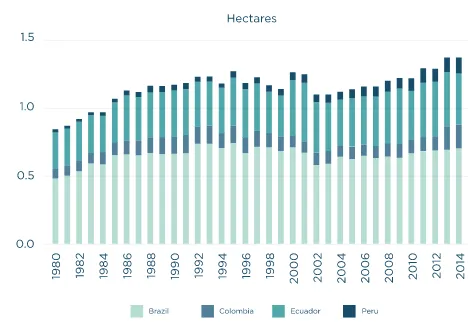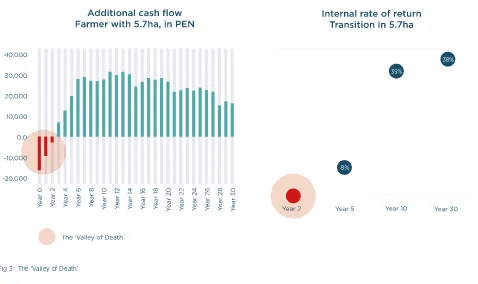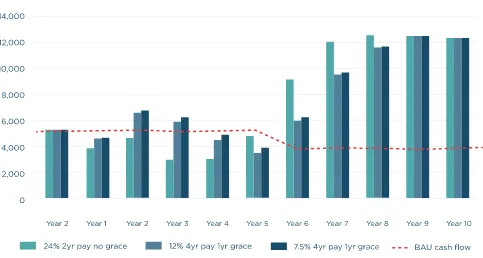Conquering the
‘Valley of Death:’
overcoming pitfalls
in financing sustainable
agriculture
Cocoa is an internationally traded commodity traditionally linked to small holder production. Many farmers in developing countries see this crop as an opportunity to move out of poverty and provide a better future for their families. Nonetheless, the expansion of this crop has been linked to deforestation, partly due to low productivity and poor management. More sustainable production systems are possible, delivering higher yields while preserving the forest and ecosystem services. However, farmers will struggle to make this transition without adequate inancial resources and support. Finance is a major block to smallholders changing production methods. Only by overcoming these obstacles will farmers survive what we call the ‘Valley of Death’ – a period of initial high costs and reduced returns. Our research suggest that better
designed credit products could provide much needed support to overcome this problem. This briefing builds on Global Canopy Programme (GCP) work in the Unlocking Forest Finance project (UFF). Since 2013, UFF has worked towards building investment portfolios in sustainable land use in three regions in the Amazon: San Martín in Peru, and Mato Grosso and Acre, both in Brazil.
Conquering the ‘Valley of Death:’ overcoming
pitfalls in financing sustainable agriculture
The case of improving cocoa yields in San Martin, Peru
According to the Food and Agriculture Organisation (FAO), in 2014 there were 10.4 million hectares of cocoa bean plantations in the world.
The environmental case for
zero-deforestation cocoa production
Ninety-six percent of this production area is distributed across Africa, Asia and South America. The global plantation area has expanded by 37% between 2000 and 2014. Most of these plantations are located in heavily forested countries, and in many cases, their expansion has been linked to deforestation. For example, Cote d’Ivoire has around 26% of the world cocoa bean plantation area. A recent boom in cocoa production in the African country caused expansion into forested areas, including national parks.
Peru has experienced a similar dynamic. Although Peru only had 1% of the world’s cocoa plantations in 2014, the country has seen a huge increase in recent years. Between 2000 and 2014, these plantations expanded by 158%. Production is growing in many Peruvian Amazon regions
including San Martin, one of the main cocoa producing regions in the country. The crop is often cultivated by migratory smallholder farmers, who cut into the forest to grow their crops. In at least one case, a private company was accused of expanding its plantation into the forest. As demand for cocoa is expected to grow, this may put additional pressure on the forest.
This growth in cocoa trade could beneit many smallholders working both in Peru and other cocoa producing regions. However, it is imperative that taking advantage of these economic opportunities is coupled with environmental protection. This has been recognised by the cocoa industry. Twelve leading cocoa companies recently committed to eliminating deforestation from the supply chain1.
1International Agri-Food Network, 2017. Cocoa Industry Announces Cooperative Initiative to End
Deforestation. [Online]. Available from: http://www.agrifood.net/198-cocoa-industry-announces-cooperative-initiative-to-end-deforestation
Fig 1 : World cocoa beans production 2014
A transition to sustainable agriculture can help boost productivity while protecting forests and the beneits they bring to people. Such a transition costs money - so it is key to develop the business case and attract investment that matches the requirements of the agricultural sector.
What is ’sustainable cocoa production’?
• A ‘no deforestation’ commitment • Cocoa in agroforestry systems
• Use of soil analysis to deine input needs (e.g. fertilisers) • Preference for organic inputs
• Improved management system and pruning • High productivity
We analysed the potential costs and beneits – environmental, social and inancial - of implementing such a system, compared to the existing management system prevalent in most cocoa plantations in San Martin, in the Peruvian Amazon. At the environmental level, we assessed the potential beneits in terms of climate, water and biodiversity as well as the risk mitigating actions that need to be implemented to ensure positive impacts. We also estimated social beneits, including additional employment, income and access to technical assistance. Financial analyses estimated the net present value of investment and the internal rate of return.
Our results show that investing in the transition to ‘sustainable cocoa production’ makes inancial sense. Alongside environmental beneits, the transition is likely to result in signiicant additional cash lows and very positive internal rates of return for producers.
Credit conditions are a major obstacle for
sustainable cocoa production in San Martin, Peru
Box 1. Business-as-usual versus sustainable ecological management
For the purposes of this analysis, we deine business-as-usual (BAU) as currently common agricultural practices with no intervention. These are characterised by use of fertilisers and pesticides that is not based on soil analysis, a higher dependency on chemicals, poor crop management, and generally small-scale monoculture. Sustainable ecological management (SEM) refers to improved practices that aim to generate and keep high productivity in the same plot of land over a longer period of time. This implies management according to soil and crop needs, more active pruning systems, better quality seeds and more reliance on organic production. Moreover, trees and other products are planted in the same plot of land.
The graphs above present the estimated additional² cash low and internal rate of return for the transition in an average cocoa farm of just under six hectares. Implementing the new system has signiicant upfront costs compared to current, less productive practices (top left graph). Nonetheless, the sustainable model is signiicantly more proitable in the medium term, creating positive returns for the farmer from Year 4. For the new system to produce an internal rate of return of 35% - which would be highly attractive - the farmer would need to wait around 10 years (top right graph). This is the ‘Valley of Death’, presenting a major obstacle for any farmer wanting to make cocoa production more sustainable.
How inance can help: Improving interest rates,
payback period and incentives in agricultural credit
Agricultural credit in Peru is characterised for its high interest rates (for average farmers and small organisations, these can reach over 24% per annum) and its short payback periods (normally 1 to 2 years). However, these terms do not match the reality of the farmer’s ability to pay during the transition process (see igure 3) where the internal rate of return is only positive from year 4 and signiicantly below 24%. In this situation there is very little incentive for farmers to access credit to transition to sustainable cocoa production.
2By additional, we mean the diference between the SEM cash low and the BAU cash low. Red bars
represent negative additional cash lows (i.e. additional costs and investments in comparison to BAU) and green bars represent positive cash lows compared to BAU production (i.e. additional revenue).
Diferent credit scenarios
To analyse diferent possible outcomes, we considered the sustainable transition (SEM) under three diferent credit scenarios, and one BAU scenario. The analysis below
presents three diferent credit scenarios for the average cocoa farmer in San Martin to shift towards sustainable production. They demonstrate how the farmer’s cash low may perform within each scenario. We make the following assumptions:
• The farmer has just under six hectares of cocoa planted using a less productive system • They want to switch to a new, more sustainable system
• They can borrow a maximum of 70% of the transition costs per hectare³. • Credit installments are spread over three years.
In the BAU cash low, we assume the traditional management system (no transition) in a running farm that requires no credit. The credit scenarios assume diferent interest rates, payback periods and grace periods⁴:
1. 24% interest per annum, two year payback and no grace period
2. 12% interest per annum, four year payback period and one year grace period 3. 7.5% interest per annum, four year payback period and one year grace period.
3 In this analysis, we do not include the technical assistance cost to be covered by the credit.
4 We deine a grace period as a period of time where the farmer only pays interest and no capital.
The graph on the left demonstrates the impact of the diferent interest rate and payback period combinations on the farmer’s cash low under diferent credit scenarios. This is in contrast to the BAU scenario, where the farmer takes no loan and maintains the same agricultural practices.
In Scenario 1, an interest rate of 24% with a payback period of two years and no grace period leaves the farmer worse of (in terms of cash low) for the irst four years and, as expected, is the alternative with lowest cash lows compared to BAU until Year 4. However, given the lower payments from Year 5 onwards, it performs better from this point.
Nonetheless, it is important to clarify that if farmers face strained cash lows during the transition, this may result in a higher rate of default. If the farmer cannot repay the debt, he or she will most likely see little to no beneit in making the transition and will most likely revert back to less sustainable practices. By spreading the loans over a longer period of time, as under the Scenarios 2 and 3, the farmer would face cash lows that are less strained and, even in some early years superior to the BAU scenario. Certainly, the farmer would pay for longer, but their payment capacity would be enhanced. This is expected under all borrowing circumstances – lower interest combined with longer payback periods are generally better.
However, if the farmer does not need to borrow under BAU⁵, a short term, very expensive loan to transition to sustainable agriculture will make them signiicantly worse of for a few years (as the graphic above shows). These smallholders risk being trapped in a diicult situation since they do not usually have enough capital or savings to cover the costs.
Why would the farmer engage into something like that? It could be argued that the long term increase in productivity and subsequent proit are incentive enough. However, farmers typically have a very short planning horizon and low capacity to cope with a shorter term income reduction while productivity increases. To be viable, the credit product should be adapted to cause the minimum possible sacriice for the farmer in the short term.
In a survey conducted by the Unlocking Forest Finance project in San Martin, we identiied that 45% of the surveyed cocoa farmers have access to credit. Out of these farmers with access to inancial resources, 20.6% of them receive this access from
inancial institutions. The current use of credit by farmers under BAU makes the business case for the transition to sustainable practices be even more compelling: if they pay the current high interest rates for short term credit under the less productive management system, signiicantly improved borrowing conditions could certainly be a powerful incentive to move towards sustainable production.
5 This assumption is not reduced in the analysis, due to the lack of information about the farmer’s other
Conclusion 1:
The farmer’s cash low can be signiicantly improved during the transition phase from current less sustainable production systems to sustainable agricultural practices. This is possible by signiicantly reducing the interest rate, extending the payback period from two to four years and including a one year grace period, where the farmer only pays interest and no capital. This is better suited to the farmer’s reality and makes the transition to sustainable practice a more feasible option. In addition, these changes would signiicantly contribute to the goals of the new agrarian policy in Peru, which aims to improve the livelihoods of small agricultural producers and improve their access to credit. National development banks could lead in incentivising sustainable agriculture. Private lenders could also participate if the right conditions are in place.
Conclusion 2:
If agricultural lenders clearly diferentiate the terms between credit for business-as-usual agriculture and its sustainable equivalent, this would be a powerful incentive for farmers in need of credit to make this transition. If similarly improved credit terms (i.e. reduced interest rate, longer payback periods and grace periods) were also available for unsustainable agriculture, this may undermine the goal of increasing the uptake of agricultural practices that increase production and preserve ecosystems. Therefore lenders must go beyond just creating green credit products to incorporate sustainability criteria into their green credit assessment and approval process.


